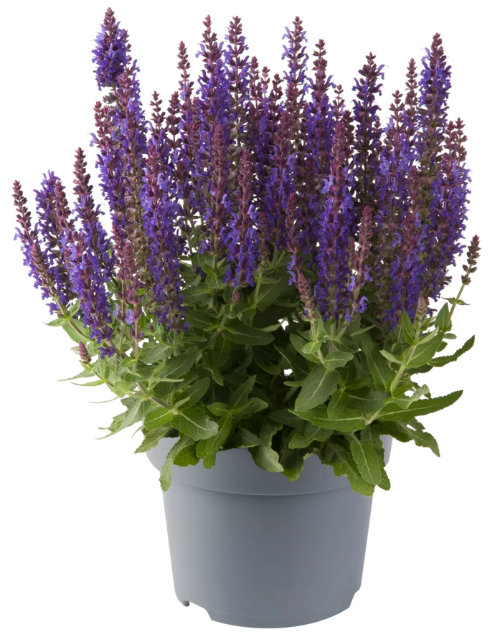Salvia (Salvia nemorosa AKA Woodland Sage,
Balkan Clary)
Last
updated: August 3,
2025
Care Sheet List
Salvia is a
popular perennial known for its long-lasting spires of purple, pink, or
white
flowers that bloom from late spring into summer. It's a fantastic plant
for
attracting pollinators and provides continuous color in garden beds and
containers.
Lighting
Salvia thrives
in full sun (at least 6 hours of direct sunlight
per day). While it can
tolerate partial sun (4-6 hours), especially in hotter climates, its
best
flowering and most compact growth occur in full sun. In Maltby, WA,
full sun
should be perfectly fine.
Watering
Routine
Once
established, salvia is quite drought tolerant.
- Initial Planting: Water regularly
after planting until the plant is established (usually for the first
few weeks to a month), keeping the soil consistently moist but not
soggy.
- Established
Plants (in Garden Beds): Water when the
top few inches of soil is dry. In most climates, natural rainfall may
be sufficient once established, but supplemental watering during
prolonged dry spells or heatwaves is beneficial.
- Potted Plants: Potted salvia
will dry out much faster than those in the ground. Check the soil
frequently and water when the top 1-2 inches feel dry to the touch.
Ensure the pot has excellent drainage.
Fertilizer
Requirements
Salvia is
not a heavy feeder, especially when planted in rich garden soil.
- In Garden Beds: If your soil is
poor, you can amend it with some compost or a balanced slow-release
granular fertilizer (e.g., Osmocote Smart-Release Plant Food
All-Purpose) in early spring. Otherwise, regular
fertilization is often not needed.
- Potted Plants: Since nutrients
leach out of pots more quickly, potted salvia will benefit from a light
feeding during the active growing season (spring and summer).
- Commercial Recommendation: Use a balanced liquid fertilizer (like Miracle-Gro
All-Purpose Plant Food (Liquid)). Dilute commercial concentrates to achieve approximately 25-50 ppm N
in your final solution, applied once a month. This is often equivalent
to using them at "half strength" or "quarter strength" of the package's
recommended dose.
- DIY Fertilizer Suggestion: For healthy growth and flowering, use your homemade 1-1-1 liquid fertilizer concentrate (Balanced).
- For 1-1-1 concentrate (10,000 ppm N): Apply at a "Light Feeding" rate, using 5 ml per 1 liter of water (resulting in ~50 ppm N, 50 ppm P₂O₅, 50 ppm K₂O). See recipe details.
- Important: Avoid
over-fertilizing, as this can lead to lush foliage but fewer flowers.
Misting
Requirements
Misting is not
necessary for salvia. These plants prefer good air
circulation and are
well-adapted to typical garden humidity levels. Misting can actually
promote
fungal issues if the leaves stay wet too long.
Pot Size
and Soil Type
- Pot Size: For a single
salvia plant, choose a pot that is at least 10-12 inches
(25-30 cm) in diameter to allow for adequate root growth and
a good display of flowers. If you plan to grow multiple plants or a
larger variety, use a bigger container. Ensure the pot has ample
drainage holes.
- Soil Type: Salvia thrives
in well-draining soil. It tolerates a range of soil
types but dislikes heavy, waterlogged conditions.
- For Garden Beds: Amend heavy
clay soils with organic matter like compost or grit to improve
drainage. If your soil is very sandy, adding compost will help with
moisture retention while maintaining drainage.
- For Potted
Plants: Use a
high-quality, well-draining general-purpose potting mix. You can
further enhance drainage by mixing in some perlite or coarse
sand (about 1 part perlite/sand to 4-5 parts potting mix).
Other
Important Care Notes:
- Deadheading/Shearing: To encourage
continuous blooming, deadhead spent flower spikes
regularly by cutting them back to the next set of leaves or basal
foliage. After the main flush of blooms in early summer, you can
perform a more aggressive "shearing" (cutting back
the entire plant by about a third to a half) to encourage a robust
second flush of flowers in late summer or early fall.
- Winter Hardiness: Salvia is
generally hardy in USDA Zones 4-9. In Maltby, WA (Zone 8b), it should
be reliably hardy in the ground. Potted plants are more vulnerable to
winter cold, so if harsh freezing temperatures are expected, you might
consider moving the pot to a more sheltered location or insulating it.
- Pest and Disease: Generally quite
resistant. Ensure good air circulation to prevent powdery mildew in
humid conditions.


